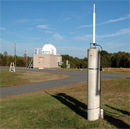- GNSS


- Realization of global accessibility to and the improvement of the International Terrestrial Reference Frame ( ITRF)
- Monitoring deformations of the solid Earth
- Monitoring crustal deformation at tide gauges
- Monitoring variations in the hydrosphere (sea level, ice-sheets, etc.)
- Orbit determination for scientific satellites
 |
DORIS is a dual-frequency Doppler system that has been included as a host experiment on various space missions. The current missions with on-board DORIS receivers are CryoSat-2, HY-2A, OSTM/Jason-2, Jason-3, Sentinel-6 Michael Freilich (S6MF), SARAL, and SPOT-4 and -5. |
 |
Unlike many other navigation systems, DORIS is based on an uplink device. The receivers are on board the satellite while the transmitters are on the ground. This creates a centralized system in which the complete set of observations is downloaded by the satellite to the ground center, from where they are distributed after editing and processing. |
 |
The DORIS permanent tracking network includes 58 permanent beacons with an even geographical distribution; this network is utilized by all missions with on-board DORIS receivers. Installation and maintenance of this ground network is performed by IGN. This map of the DORIS network is also available in PDF form. |
The Doppler Orbitography by Radiopositioning Integrated on Satellite (DORIS) was developed by the Centre National d'Etudes Spatiales (CNES) with the cooperation of Groupe de Recherche en Géodésie Spatiale (GRGS) and the Institut Géographique National (IGN). The system was developed to provide precise orbit determination and high accuracy location of ground beacons for point positioning. An accurate measurement is made of the Doppler shift on radiofrequency signals emitted by the ground beacons and received on the spacecraft.
In addition to POD applications some of the scientific uses of DORIS data include:

